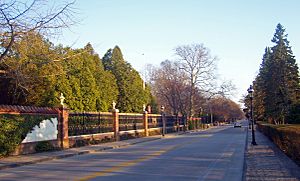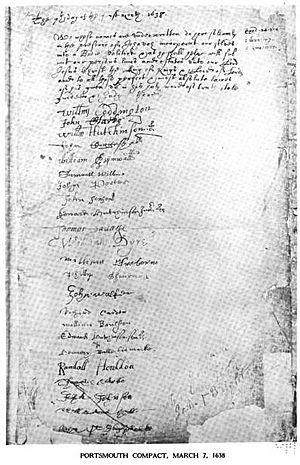John Coggeshall facts for kids
Quick facts for kids
John Coggeshall Sr.
|
|
|---|---|

John Coggeshall grave medallion
|
|
| 1st President of the Colony of Rhode Island and Providence Plantations | |
| In office 1647–1647 |
|
| Preceded by | position created |
| Succeeded by | Jeremy Clarke |
| Personal details | |
| Born | 2 December 1599 Halstead, Essex, England |
| Died | 27 November 1647 Newport, Rhode Island |
| Resting place | Coggeshall Cemetery, Newport, Rhode Island |
| Children | John, Anne, Mary, James, Joshua, Hananiel, Wait, Bedaiah |
| Occupation | Merchant, selectman, deputy, corporal, moderator, president |
John Coggeshall Sr. (born 1599, died 1647) was an important person in the early days of the Colony of Rhode Island and Providence Plantations. He helped start the colony and became its first President. Before coming to America, he was a successful silk merchant in England.
He moved to the Massachusetts Bay Colony in 1632 and quickly took on many government jobs. However, he supported people like Anne Hutchinson who had different religious ideas. Because of these differences, he had to leave Massachusetts. He then helped create new settlements that became part of Rhode Island.
Contents
John Coggeshall's Early Life
From England to Massachusetts
John Coggeshall was born in Halstead, England. His parents were John and Ann Coggeshall. He grew up in Essex, England. After he got married, he lived in Castle Hedingham, where he worked as a merchant.
In 1632, John Coggeshall and his family joined many other English Puritans moving to New England. They sailed on a ship called the Lyon. This was the same ship that carried Roger Williams a year earlier.
The Coggeshalls first settled in Roxbury, near Boston. They joined the Roxbury Church the same year they arrived. Later, in 1634, they moved to Boston. There, they became neighbors with William and Anne Hutchinson.
Why He Left Massachusetts
John Coggeshall was a mercer, which means he sold silks and other fabrics. He held many important jobs in the Massachusetts Bay Colony. He was a representative for Boston in the General Court (like a government assembly) from 1634 to 1637. He was also a selectman (a local official) during that time.
After moving to Boston, Coggeshall became a strong supporter of Anne Hutchinson. She was at the center of a big religious disagreement in the colony. Many people in Boston, including the governor at one point, supported her. However, the new governor, John Winthrop, wanted to stop these different religious ideas.
Anne Hutchinson was put on trial and told to leave the colony. This was because of her religious beliefs and her influence on the community. At her trial, John Coggeshall spoke up for her. He was one of only three representatives who voted for her to be found innocent. He also supported another religious leader, Reverend John Wheelwright.
Because he supported Hutchinson, Coggeshall was also told to leave Massachusetts in March 1638.
Starting a New Life in Rhode Island
The Portsmouth Compact
Many of Anne Hutchinson's supporters were ordered to leave Massachusetts. Before they left Boston, a group of them, including Coggeshall, signed an agreement called the Portsmouth Compact. This agreement helped them create a new government based on what the people living there wanted.
The group first planned to settle in New Netherland. But Roger Williams convinced them to buy land from the Native Americans in Narragansett Bay. They moved to the northeast part of Aquidneck Island (which was called Rhode Island back then). They started a settlement called Pocasset, which later changed its name to Portsmouth in 1639.
William Coddington was chosen as the first leader, called a "judge." In May 1638, Coggeshall helped plan out the land in Portsmouth. He was given six acres of land there.
Founding Newport
The next year, in 1639, there was a disagreement among the leaders in Portsmouth. Because of this, Coddington and several other leaders, including Coggeshall, left Portsmouth. They moved to the south end of the island and started a new town called Newport.
The governor of Massachusetts, John Winthrop, wrote in his journal that "the people grew very tumultuous and put out Mr. Coddington and the other three magistrates." Coggeshall was one of those three leaders.
Becoming President of Rhode Island

John Coggeshall quickly became a leader in Newport. He was given 400 acres (about 1.6 square kilometers) of land on the south side of the town, near what is now Bellevue Avenue. In 1638, he was elected as the treasurer. From 1640 to 1647, he served as an assistant to the governor.
He worked well with Roger Williams. This helped the towns of Portsmouth, Newport, Providence, and Warwick to join together. They formed the Colony of Rhode Island and Providence Plantations in the spring of 1647. This was possible because Williams had gotten an official document (called a patent) from the King in 1644.
In May 1647, Coggeshall was elected the main leader of the four-town colony. His title was President. He had an assistant from each town, a general recorder (who kept records), and a treasurer. During his time as President, they set up courts and wrote the first complete set of laws for the colony.
A historian named Samuel G. Arnold praised these laws. He said they were simple, clear, and formed the basis for all the laws that came after them in Rhode Island.
Coggeshall was President for only a short time. He died in Newport on November 27, 1647, and was buried on his own property. He is remembered as the first president of the united Colony of Rhode Island and Providence Plantations. He also helped establish important towns like Boston, Portsmouth, and Newport.
Family and Legacy
John Coggeshall's wife was named Mary. They had eight children. Five of them were born in England, and the others were born in Boston. Only half of their children lived to be adults.
Their oldest child, John, was also very active in the colony's government for over 30 years. He served as treasurer, commissioner, assistant, and deputy governor. Their son Joshua also held public office. He was a representative to the General Court of Rhode Island and an assistant (magistrate).
Their oldest daughter, Ann, married Peter Easton. Peter was the son of Nicholas Easton, who served many terms as either president or governor of Rhode Island. Their daughter Wayte married Daniel Gould. One of their descendants, Elizabeth Buffum Chace, was an abolitionist who helped people escape slavery through the Underground Railroad.
Several places are named after President Coggeshall. These include John Coggeshall Elementary School in Portsmouth, Rhode Island. There are also Coggeshall Way and Coggeshall Circle in Middletown, and Coggeshall Avenue in Newport. Coggeshall Avenue goes through the land that John Coggeshall originally owned.


